Noise pollution is a significant environmental concern in urban areas, affecting millions of people worldwide and posing various health risks. To effectively address this issue, cities are turning to innovative technologies such as acoustic maps for comprehensive noise pollution monitoring and management. In this detailed article, we’ll explore the concept of acoustic maps, their applications, benefits, and how they can contribute to creating quieter and healthier urban environments.
Introduction to Acoustic Maps
Acoustic maps, also known as sound maps or noise maps, are visual representations of noise levels across different locations within urban areas. These maps utilize data from various sources, including sound sensors, traffic monitoring systems, and citizen reports, to provide real-time insights into noise pollution levels and distribution patterns. We’ll delve into the fundamentals of acoustic mapping technology and its role in understanding the spatial and temporal dynamics of noise pollution.
Advantages of Acoustic Mapping Technology
Acoustic mapping technology offers numerous advantages for noise pollution monitoring and management in urban environments. We’ll discuss how acoustic maps provide valuable information for city planners, policymakers, and researchers to identify noise hotspots, assess the impact of transportation and industrial activities, and develop targeted interventions to mitigate noise pollution. Additionally, we’ll explore the role of acoustic maps in raising public awareness and fostering community engagement in noise abatement efforts.
Creating Accurate and Detailed Noise Profiles
One of the key benefits of acoustic maps is their ability to create accurate and detailed noise profiles of urban areas, allowing stakeholders to gain a comprehensive understanding of noise sources, propagation pathways, and exposure levels. We’ll examine the methodologies and technologies used to collect, analyze, and visualize noise data, including the use of GIS (Geographic Information Systems) software, machine learning algorithms, and crowdsourcing platforms, to create high-resolution acoustic maps with spatial and temporal granularity.
Assessing Environmental Impact and Health Risks
Acoustic maps play a vital role in assessing the environmental impact of noise pollution on human health and well-being. We’ll explore how noise exposure metrics derived from acoustic maps, such as Lden (Day-Night Average Sound Level) and Lden (Community Noise Equivalent Level), are used to evaluate the adverse effects of noise on sleep quality, cardiovascular health, cognitive performance, and overall quality of life. Additionally, we’ll discuss the importance of integrating noise mapping data with other environmental and demographic indicators to identify vulnerable populations and prioritize mitigation measures.
Supporting Urban Planning and Policy Development
Acoustic maps serve as valuable tools for supporting urban planning and policy development initiatives aimed at reducing noise pollution and improving urban livability. We’ll highlight case studies and best practices from cities around the world that have successfully integrated acoustic mapping into their planning processes, leading to the implementation of noise abatement strategies, land use zoning regulations, and transportation infrastructure improvements. Additionally, we’ll discuss the role of acoustic maps in evaluating the effectiveness of noise control measures and monitoring compliance with noise regulations.
Empowering Citizen Science and Engagement
Acoustic maps empower citizens to actively participate in noise pollution monitoring and mitigation efforts through citizen science initiatives and participatory mapping projects. We’ll explore how crowdsourced data collection platforms and smartphone apps enable individuals to contribute noise measurements, report noise complaints, and advocate for policy changes in their communities. Additionally, we’ll discuss the potential of acoustic maps to facilitate public dialogue, foster collaboration between stakeholders, and build social resilience against noise pollution.
In conclusion, acoustic maps represent a powerful tool for monitoring, analyzing, and mitigating noise pollution in urban areas. By providing comprehensive insights into noise levels, sources, and impacts, acoustic mapping technology enables cities to make informed decisions, implement targeted interventions, and create healthier, more livable environments for residents. As the global urban population continues to grow, the importance of acoustic maps in managing noise pollution will only increase, driving innovation and collaboration in the field of environmental acoustics.
